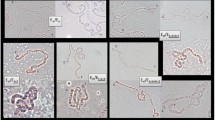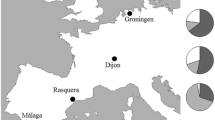Abstract
Concern regarding the ecological impact of rapid global warming has encouraged research on climate-induced changes in biological systems. Critical problems, still poorly understood, are the potential for rapid adaptive responses and their genetic costs to populations. The O chromosomal polymorphisms of Drosophila subobscura have been monitored at a southern Palearctic locality experiencing sustained climate warming since the mid-1970s. Observations suggest that the population is rapidly evolving in response to the new environmental conditions, and has lost a significant amount of chromosomal diversity (18.3% in 16 years). These findings are consistent with results from another population of D. subobscura, which is also undergoing climate warming, and are in accord with what would be expected from latitudinal and seasonal patterns of the various inversions. In addition, data on the O chromosomal polymorphisms from other localities throughout t he range of this species suggest that other populations vary similarly.
Similar content being viewed by others
References
Anderson, W.W., Arnold, J., Baldwin, D.G., Beckenbach, A.T., Brown, C.J., Bryant, S.H., Coyne, J.A., Harshman, L.G., Heed, W.B., Jeffrey, D.E., Klaczko, L.B., Moore, B.C., Porter, J.M., Powell, J.R., Prout, T., Schaeffer, S.W., Stephens, J.C., Taylor, C.E., Turner, M.E., Williams, G.O. and Moore, J.A. (1991) Four decades of inversion polymorphism in Drosophila pseudoobscura. Proc. Natl. Acad. Sci. USA 88, 10367–10371.
Bennett, A.F., Dao, K.M. and Lenski, R.L. (1990) Rapid evolution in response to high-temperature selection. Nature 346, 79–81.
Bulmer, M.G. (1980) The Mathematical Theory of Quantitative Genetics. Clarendon Press, Oxford.
Carson, H.L. (1955) Variation in genetic recombination in natural populations. J. Cell. Comp. Physiol. 45 (suppl. 2), 221–236.
Dobzhansky, T.H. (1947) A response of certain gene arrangements in the third chromosome of Drosophila pseudoobscura to natural selection. Genetics 32, 142–160.
Fontdevila, A., Zapata, C., Álvarez, G., Sánchez, L., Méndez, J. and Enríquez, J. (1983) Genetic coadaptation in the chromosomal polymorphism of Drosophila subobscura. I. Seasonal changes of gametic disequilibrium in a natural population. Genétics 105, 935–955.
Gosteli, M. (1990) Chromosomal polymorphism in natural populations of Drosophila subobscura near Zürich, Switzerland: A contribution to long-term comparisons. Genética 81, 199–204.
Gosteli, M. (1991) Differential flight activity among karyotypes: Daily and weather induced changes in chromosomal inversion polymorphism in natural populations of Drosophila subobscura. Genética 84, 129–136.
Holt, R.D. (1990) The microevolutionary consequences of climate change. Tree 5, 311–315.
Johannessen, O.M., Bjùrgo, E. and Miles, M.W. (1996) Global warming and the Arctic. Science 271, 129.
Jones, P.D., Wigley, T.M.L. and Wright, P.B. (1986) Global temperature variations between 1981 and 1984. Nature 322, 430–434.
Kerr, R.A. (1992) When climate twitches, evolution takes great leaps. Science 257, 1622–1624.
Krimbas, C.B. (1992) The inversion polymorphism of Drosophila subobscura. In Drosophila Inversion Polymorphism (C.B. Krimbas and J.R. Powell, eds), pp. 127–220. CRC Press, Boca Raton, FL.
Krimbas, C.B. and Loukas, M. (1979) Drosophila subobscura: Lengths, of chromosome segments heterozygote for inversions, to be used in IFR calculations. Eur. Dros. Popul. Biol. Group. Bull. 3, 1–7.
Krimbas, C.B., and Loukas, M. (1980) The inversion polymorphism of Drosophila subobscura. Evol. Biol. 12, 163–234.
Krimbas, C.B. and Powell, J.R. eds (1992) Drosophila Inversion Polymorphism. CRC Press, Boca Raton, FL.
Lande, R. and Shannon, S. (1996) The role of genetic variation in adaptation and population persistence in a changing environment. Evolution 50, 434–437.
Lynch, M. and Lande, R. (1993) Evolution and extinction in response to environmental change. In Biotic Interactions and Global Change (P.M. Kareiva, J.G. Kingsolver and R.B Huey, eds), pp. 234–250. Sinauer Associates, Sunderland, MA.
Menozzi, P. and Krimbas, C.B. (1992) The inversion polymorphism of Drosophila subobscura revisited: Synthetic maps of gene arrangements frequencies and their interpretation. J. Evol. Biol. 5, 625–641.
Misra, R.K. and Reeve, E.C.R. (1964) Clines in body dimensions in populations of Drosophila subobscura. Genet. Res. 5, 240–256.
Moltó, H.D., Pascual, L., Martínez-Sebastián, H.J. and De Frutos, R. (1992) Genetic analysis of heat shock in the three Drosophila species of the obscura group. Genome 35, 870–880.
Orengo, D.-J. and Prevosti, A. (1996) Temporal changes in chromosomal polymorphism of Drosophila subobscura related to climatic changes. Evolution 50, 1346–1350.
Parsons, P.A. (1991) Biodiversity conservation under global climatic change: The insect Drosophila as a biological indicator? Global Ecol. Biogeogr. Lett. 1, 77–83.
Prevosti, A. (1966) Chromosomal polymorphism in Western Mediterranean populations of Drosophila subobscura. Genet. Res. 7, 149–158.
Prevosti, A., Ribó, G., Serra, L., Aguadé, M., Balaña, J., Monclús, M. and Mestres, F. (1988) Colonization of America by Drosophila subobscura: Experiment in natural populations that supports the adaptive role of chromosomal-inversion polymorphism. Proc. Natl. Acad. Sci. USA 85, 5597–5600.
Quintana, A. and Prevosti, A. (1991) Genetic and environmental factors in the resistance of Drosophila subobscura adults to high temperature shock. III. Chromosomal-inversion and enzymatic polymorphism variation in lines selected for heat shock resistance. Genética 84, 165–170.
Rodríguez-Trelles, F. (1993) Análisis estacional de sistemas gené ticos multiloci y estructura gené tica en una población natural de Drosophila subobscura. PhD thesis, Universidade de Santiago de Compostela, Spain.
Rodríguez-Trelles, F., Álvarez, G. and Zapata, C. (1996) Time-series analysis of seasonal changes of the O inversion polymorphism of Drosophila subobscura. Genetics 142, 179–187.
Rozas, J., Segarra, C., Zapata, C., Álvarez, G. and Aguadé, M. (1995) Nucleotide polymorphism at the rp49 region of Drosophila subobscura: Lack of geographic subdivision within chromosomal arrangements in Europe. J. Evol. Biol. 8, 355–367.
Saura, A. (1994) Genetic load and population size in northern populations of Drosophila subobscura. In Genetics of Natural Populations: The Continuing Importance of Theodosius Dobzhansky (L. Levine, ed.), pp. 173–187. Columbia University Press, New York.
Schneider, S.H. (1993) Scenarios of global warming. In Biotic Interactions and Global Change (P.M. Kareiva, J.G. Kingsolver and R.B. Huey, eds), pp. 234–250. Sinauer Associates, Sunderland, MA.
Travis, J. and Futuyma, D.J. (1993) Global change: Lessons from and for evolutionary biology. In Biotic Interactions and Global Change (P.M. Kareiva, J.G. Kingsolver and R.B. Huey, eds), pp. 251–263. Sinauer Associates, Sunderland, MA.
Tucic, N. (1979) Genetic capacity for adaptation to cold resistance at different developmental stages of Drosophila melanogaster. Evolution 33, 350–358.
Vitousek, P.M. (1992) Global environmental change: An introduction. Annu. Rev. Ecol. Syst. 23, 1–14.
Wallace, J.M., Zhang, Y. and Renwick, J.A. (1995) Dynamic contribution to hemispheric mean temperature trends. Science 270, 780–783.
Wright, S. and Dobzhansky, T.H. (1946) Experimental reproduction of some of the changes caused by natural selection in certain populations of Drosophila pseudoobscura. Genetics 31, 125–156.
Zivanovic, G., Milanovic, M. and Andjelkovic, M. (1995) Chromosomal inversion polymorphism of Drosophila subobscura populations from Jastrebac Mountain shows temporal and habitat-related changes. J. Zool. Syst. Evol. Res. 2, 81–83.
Author information
Authors and Affiliations
Rights and permissions
About this article
Cite this article
Rodríguez-Trelles, F., Rodríguez, M.A. Rapid micro-evolution and loss of chromosomal diversity in Drosophila in response to climate warming. Evolutionary Ecology 12, 829–838 (1998). https://doi.org/10.1023/A:1006546616462
Issue Date:
DOI: https://doi.org/10.1023/A:1006546616462




